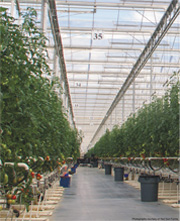According to Khosla, “Greenhouses present the ability to use IPM to its fullest potential. For example, they allow for successful introductions of beneficial insects to control pest populations, thereby reducing the amount of pesticides used in greenhouse production.”
In addition to new developments in IPM bio-agents, Kholsa also cites a number of other trends in larger operations, such as building taller structures (for better internal climate management), the use of glass rather than plastic or polycarbonate (the former allows more light, does not fade over time, and is resistant to pollutants and radiation), more efficient recycling (of nutrient solutions to reduce waste and save expenses), and further developments in hydroponic “bag culture” production, which conserves space and allows for greater flexibility.
“Some of the latest trends in greenhouse growing include more automation, from picking to sorting to packing and pallet building,” notes Ray Wowryk, director of business development for Nature Fresh Farms in Leamington. This is borne out by the statistics, as the number of permanent greenhouse production workers fell by 2.2 percent in recent years. Total operating expenses, largely due to labor costs and technology upgrades, have risen by just 0.3 percent, significantly lower than sales increases.
“Automation has dramatically improved over the past year,” agrees Harold Paivarinta, director of sales and business development at Red Sun Farms (part of Jem-D International based in Leamington). “One of our farms employs robotics in its packing house and we have installed state-of-the-art packing equipment at all of our locations to drive efficiency.”
Wowryk also notes new technologies have furthered the boundaries of year-round growing, such as ‘interplanting’ or planting multiple crops with varying maturity dates. With staggered growth patterns and harvests, growers can control and extend the season.
The use of interplanting, Wowryk says, “is a much more common practice than it has been in years past.”
Paivarinta notes, “High-wire cucumber growing seems to be catching on more and more. And on the product side, snacking and bite-sized tomatoes continue to be the fastest growing subcategory in our industry.” Indeed, though much of the overall tomato market has been flat or declining, tiny or cocktail tomatoes, often available in red, orange, and yellow varieties, have continued to climb in demand.
~ Distribution ~
There’s no disputing the success of the greenhouse sector in Ontario, which now accounts for 63.3 percent of Canada’s national greenhouse sales. But the trend doesn’t stop there, as many growers are expanding production to other locations outside Ontario and Canada. Much of this has to do with the ability to save on costs and increase freshness by getting greenhouse-grown fruits and vegetables to key markets more quickly.



